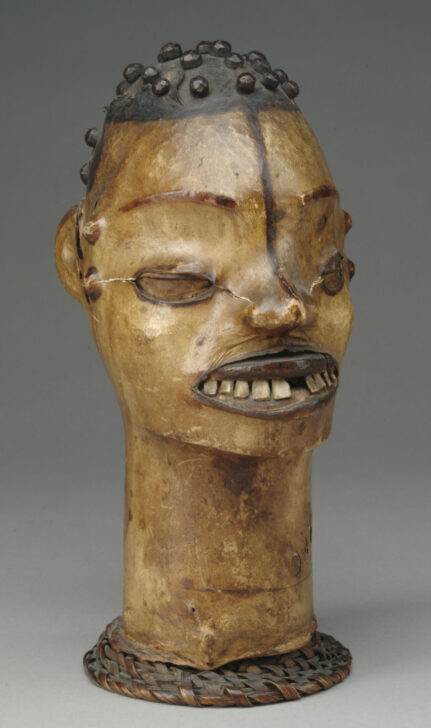Mask
Ejagham

Description
Subject Matter:
The Cross River region on the border between Nigeria and Cameroon has a long history of trade and sharing artistic styles among the many peoples that call the area home. The practice of covering wooden masks with animal skin is thought to have originated with Ejagham peoples (formerly called Ekoi). Cap masks such as this one were worn with a raffia base on top of the head; other forms of skin-covered masks were also made, including Janus-faced and hemlet masks, thought not in recent years. While masks were usually named after the society they were used with, it is not known what society this mask belonged to. In general, they were used in festivals for entertainment and for important ceremonial occasions. They were also worn for funerals of important society members. With this kind of mask the costume consisted of long gown covering whole body. The lighter skin color suggests this may be a female mask, which could possibly have been worn by men.
References Cited:
Nicklin, Keith. 1974. "Nigerian Skin-Covered Masks." African Arts, Vol. 7, No. 3, pp. 8-15+67-68+92.
Nicklin, Keith. 1979. "Skin-Covered Masks of Cameroon." African Arts, Vol. 12, No. 2, pp. 54-59+91-92.
Physical Description:
Wooden mask in the shape of human head, covered with animal skin, possibly antelope. The head is ovoid shaped with a small nose and an open mouth filled with teeth. The ears are small and there is a dark line running from the top of the forehead to the bottom of the nose. There are two raised marks on each side of the face. The top of the head is darkened and has small, wooden pegs to represent hair.
Usage Rights:
If you are interested in using an image for a publication, please visit https://umma.umich.edu/request-image/ for more information and to fill out the online Image Rights and Reproductions Request Form.